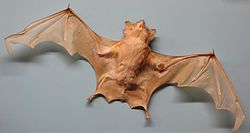| Long-winged tomb bat | |
|---|---|
 | |
| Scientific classification | |
| Kingdom: | Animalia |
| Phylum: | Chordata |
| Class: | Mammalia |
| Order: | Chiroptera |
| Family: | Emballonuridae |
| Genus: | Taphozous |
| Species: | T. longimanus |
| Binomial name | |
| Taphozous longimanus Hardwicke, 1825 | |
 | |
| Long-winged tomb bat range | |
Wikimedia Commons has media related to Taphozous longimanus .
The long-winged tomb bat (Taphozous longimanus) is a species of sac-winged bat in the family Emballonuridae. It is found in Bangladesh, Cambodia, India, Indonesia, Malaysia, Myanmar, Singapore, Sri Lanka, and Thailand.
